Aye, Claudia! Fast Times with an Early Claud Butler Mixte
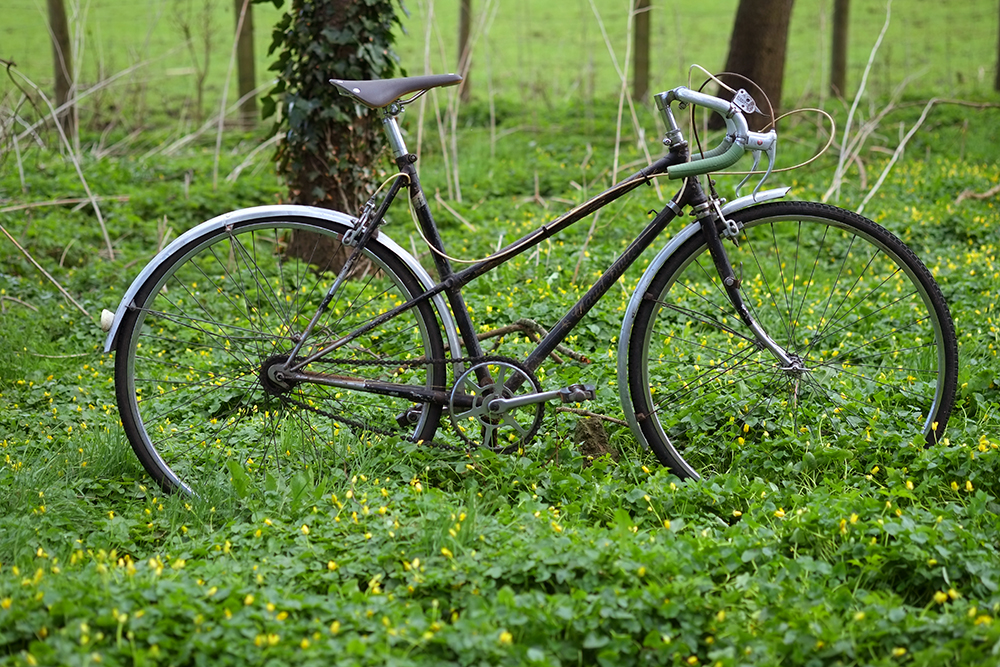
"An unusual design of particularly rigid type and pleasing in appearance," boasts the 1936 Claud Butler Catalogue about their new mixte framed bicycle. Judging by earlier catalogues, a Lady Lightweight model had been on offer for at least three years by this time. However, its initial and rather unremarkable step-through iteration must have proven less than fully satisfying to the manufacturer. Enter this new "open-frame machine of rigid design" offering "strength in the right places, but with lightness and easy running." Indeed, this Lady’s Machine had "all the advantages of the Gent’s diamond frame type" whilst being "specially designed to be suitable for both rational costumes and skirts, absolutely rigid and comfortable." Amazingly, all of this was achieved “inside 26 lb."

There are several things that make this early Claud Butler mixte remarkable - starting with the very fact that it is an early mixte, and an English one at that. While no one can pinpoint precisely when mixte designs (which are thought to be French in origin) began, the earliest known examples date back to the 1930s, making this bicycle one of the earliest of its kind.

More interesting still is the kind of mixte this Claud Butler is. As lovers of this breed of bicycles know, there are, broadly speaking, two types of mixte frame construction: The classic type, where in leu of a top tube, a pair of twin parallel stays runs from the head tube all the way to the rear dropouts (for example, see here). And the alternative type, where a single dropped top tube splits into two parallel stays at the seat tube, these stays then extending to the dropouts (for example, see here). It is commonly assumed that the "classic" twin stays design came first, and the alternative design was developed later, as a means of improving frame rigidity. However, Claud Butler's early use of the alternative design contradicts this, indicating instead that the two methods of mixte frame construction must have existed simultaneously from the very start. And, if I may indulge in some speculation: As the word "mixte" appears nowhere in Claud Butler's literature, it is possible also that the construction we see on this bicycle may have been developed by English builders, whereas the twin-stay construction was developed by French builders - and that, as the years went on, they simply began to use each other's methods. This is my working hypothesis at least...
But gosh, I am forgetting myself. Forgive me for plunging into this technical discussion so quickly! To take it down a notch, let me tell you about Claud Butler and how I came to possess his super cool bicycle.
 Before its cruel resurrection as a modern-day budget bike warehouse brand, the name Claud Butler was known mostly to collectors of Classic English Lightweights - early bespoke roadbikes, made, often quite exquisitely, by a handful of skilled UK frame builders. Despite his name's suggestion of Frenchness, Claud Butler the man was English - the son of a silk industry worker, who rejected the family trade to pursue his interest in bicycles. He first opened a bicycle dealership in London, then progressed to having frames of his own design manufactured in-house.
Before its cruel resurrection as a modern-day budget bike warehouse brand, the name Claud Butler was known mostly to collectors of Classic English Lightweights - early bespoke roadbikes, made, often quite exquisitely, by a handful of skilled UK frame builders. Despite his name's suggestion of Frenchness, Claud Butler the man was English - the son of a silk industry worker, who rejected the family trade to pursue his interest in bicycles. He first opened a bicycle dealership in London, then progressed to having frames of his own design manufactured in-house. 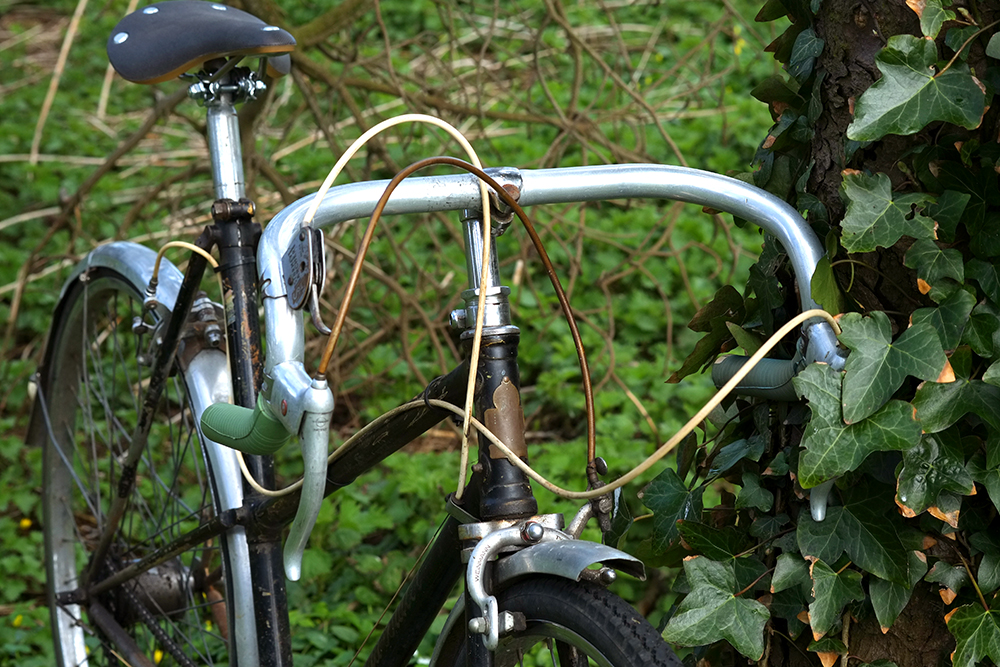
Fairly quickly, Claud Butler bicycles became known for a fashionable sort of aggressiveness. While competitors promoted elaborate lugwork and "flamboyant" finishes, Claud Butler bicycles were among the first to adapt lugless (fillet brazed) construction. In their catalogues and marketing literature, a sleek "racy" aesthetic with restrained flourishes was accompanied by references to lightness, rigidity, short wheelbases and low bottom brackets. All bicycle models, including the Lady Lightweight, were made to order and could be purchased in a standard size and build, or made to measure and in a bespoke configuration. The bicycle in my possession was, most likely, a custom order, as the frame size is in between the sizing advertised. Luckily, it is a size that suits me very nicely!
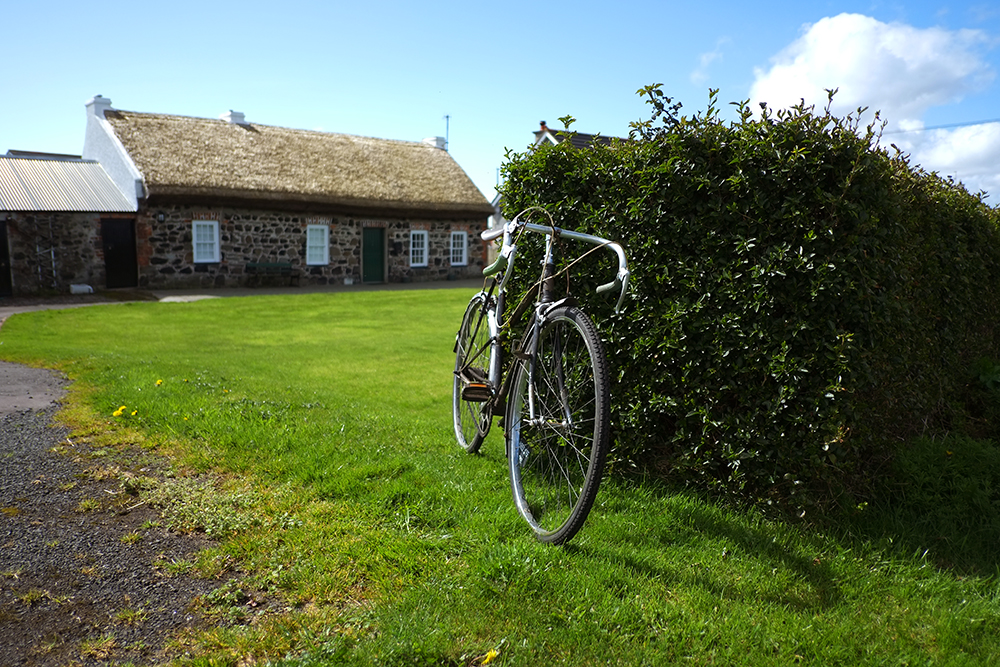
...Speaking of which: How on earth did this rare darling of a bicycle make its way toward these thatched cottage-ridden banks of the Lough Foyle? Well, funny story. My buddy Bryan from County Donegal brought it over during a vintage bike meetup we organised last summer, so that I could have a look and photograph it. Then he suggested that I ride it. Ten miles later, we had a VGA (Velo-Guardianship Agreement) in place. When Bryan left, the bicycle stayed with me.
What is a VGA, some of you might be wondering? Ah. Well, okay: Say you have a bicycle that's really cool and special in some way. You do not ever intend to sell it. Yet you also never ride it (this could be because the bicycle is the wrong size for you, because you're moving away, or for any number of other reasons), while at the same time, being of the belief that bicycles - no matter how rare and special - should be ridden. So when you meet someone who you think will ride this bicycle, and will appreciate its specialness like you do, you can make an agreement to "sell" them the bike for a token price, with the understanding that, should this person not want the bicycle in the future, they will sell it back to you for this same price, as opposed to selling it on the open market or giving it to anybody else. So in a sense, the bike is still yours. But the other person can be its guardian, as long as they ride it and take care of it. Several of my former bicycles are out in the world under a standing VGA, and it's great - I love seeing photos of them out and about, being used as intended. Similarly, considering that Bryan is around 7ft tall and his Claud Butler was made for a lady of my size, I imagine he gets some satisfaction from the bicycle living an active and happy life in my care. At the same time, I do not really think of this bicycle as truly mine. But I am certainly happy and grateful to have it under my guardianship for the time being! Oh, and in case it's not obvious, I have called it Claudia. Very creative, I know.
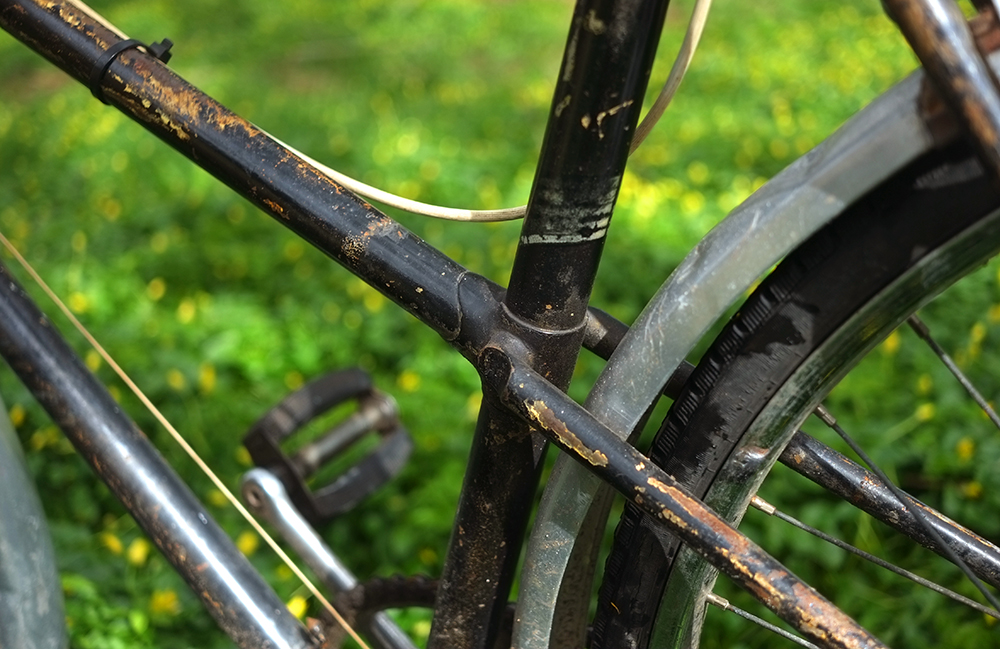
As I have already mentioned, there are many interesting things about Claudia. The mixte construction is one of them, and so I include some pictures of relevant lug p0rn for your enjoyment.
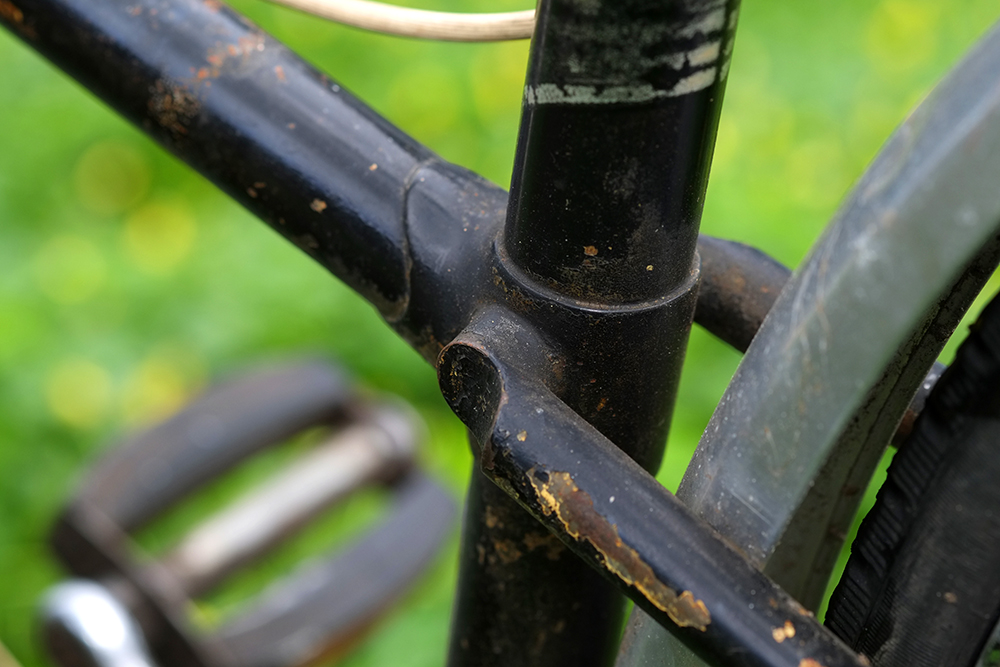
Mmmm...
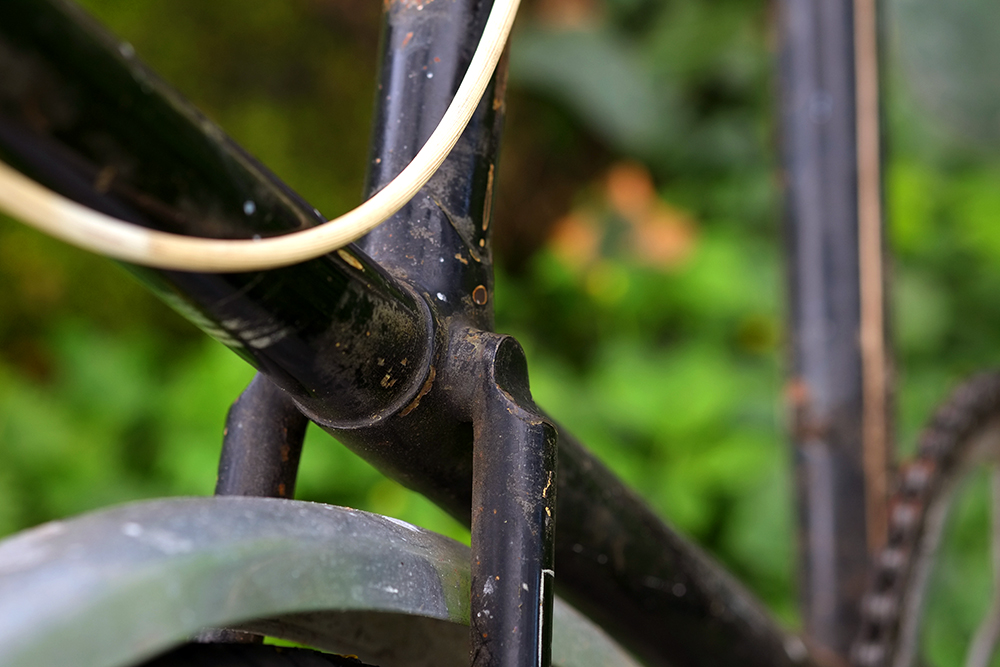
Aaaah...
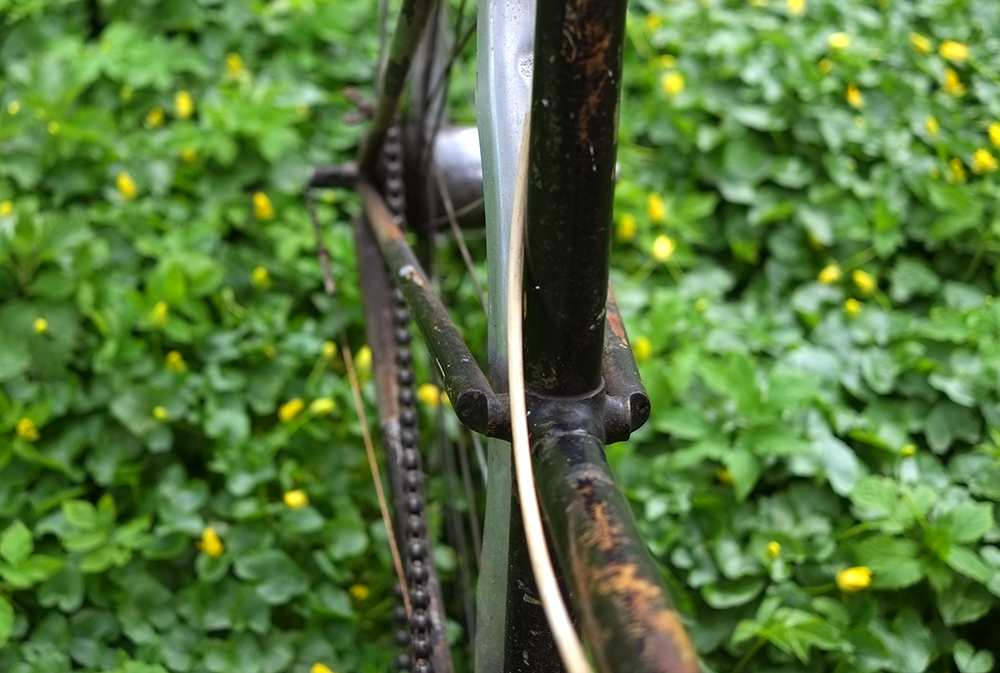
That's right!
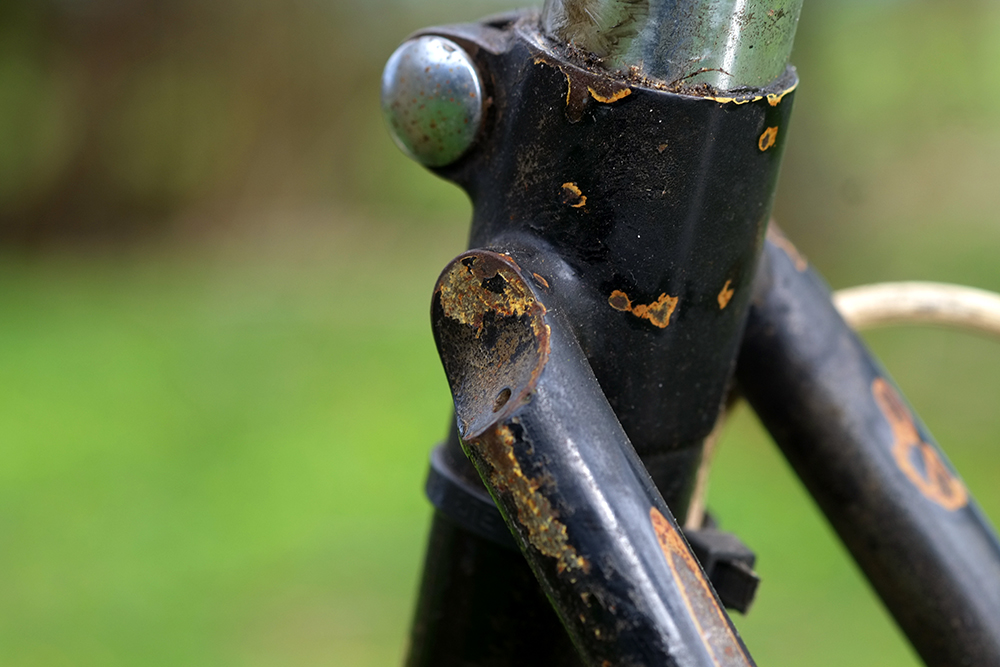
And here is a matching seat cluster for good measure. Black on black lugwork is really hard to photograph, by the way, so I hope you appreciate my dedication.

The head lugs have screws in them. I have seen this on frames from the same era before
But the really interesting thing about the head tube on this bicycle, is that it is teeny-tiny - in fact, it is slightly lower in height than the seat tube. That is to say, this bicycle's virtual top tube slopes downward, as it were. This type of geometry can be seen on time trial bicycles, but very rarely on ordinary roadbikes - let alone "lady's bicycles!" More typically, on a step-through or mixte we would see an extended head tube design, allowing the handlebars to be placed extra high (see: What Is a High Nelly?) to ensure an upright posture. But in 1936, Claud Butler saw fit to make the Lady Lightweight unusually aggressive.
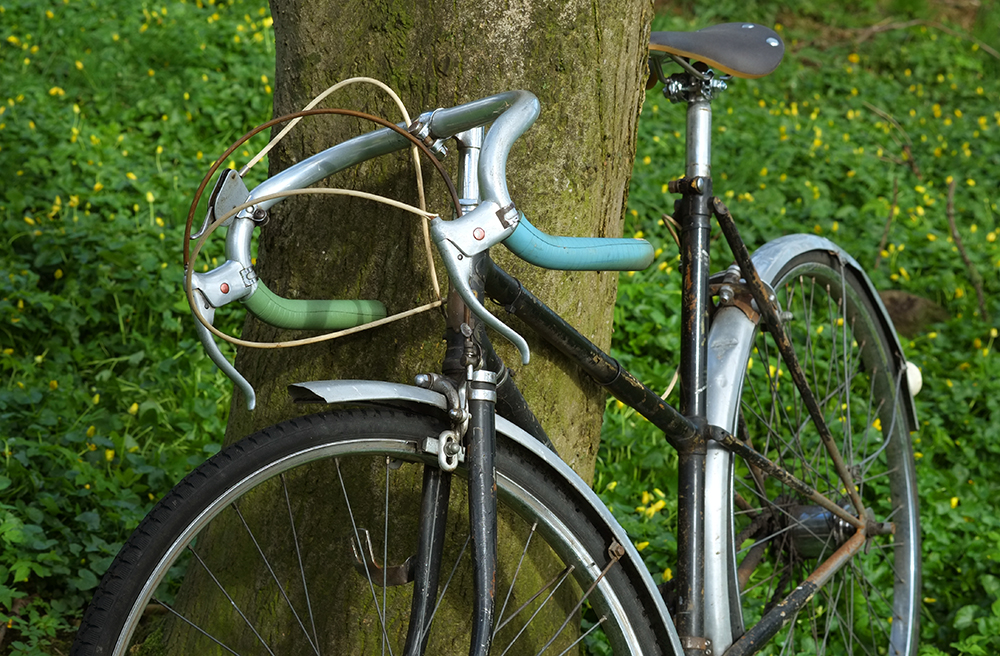
And if that weren't enough, this little minx of a mixte is fitted with some crazily-deep drop handlebars, designed in a way that make them impossible to grip anywhere but on the drops. The handlebars currently on the bike are Stratalite Tour de France bars - which I do not think are original, as I cannot find any pre-war examples of this brand. However, the Claud Butler catalogue states this bicycle can be fitted with a variety of drop bars, so it is reasonable to assume the original owner rode it with a similar setup, perhaps replacing the original bars with newer ones along the way. Here, for instance, is a 1939 catalog that shows a later version of the same bicycle fitted with drops.
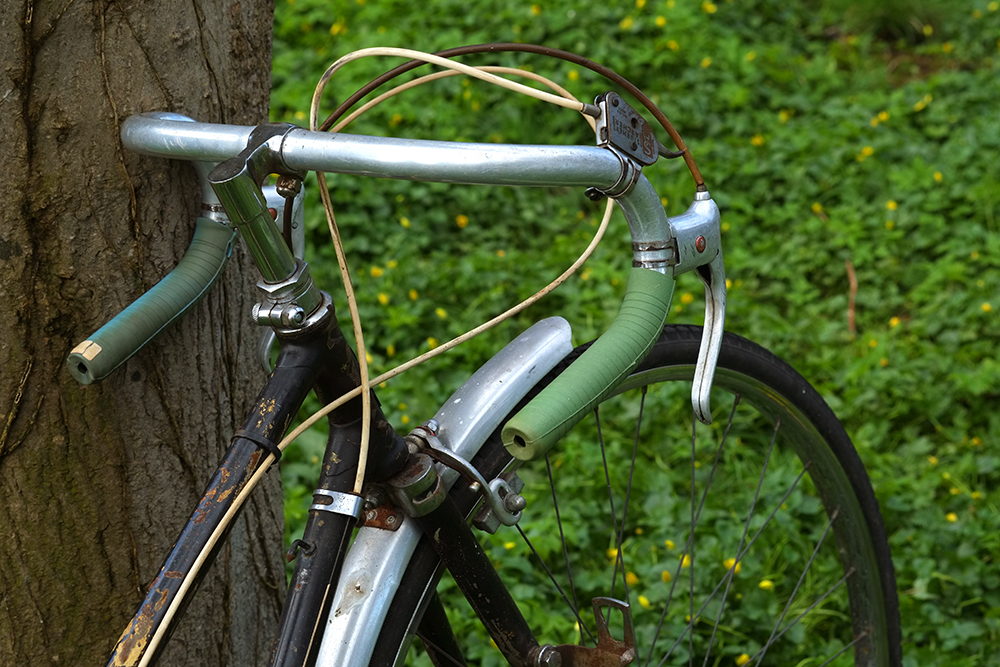
Originally the bike came with some ill-fitting 1960s city bike grips, which did not reach the brake levers. But thanks to Nick of the Three Speed Hub, I got my hands (ha!) on these period-correct New Old Stock long rubber grips in my favourite sage green colour. They are a perfect length for reaching the brake levers, and feel extremely comfortable. Under certain light conditions, the grips look a different colour, showing that the side that had been exposed to the sun (they must have lain on a store-front window sill I am guessing) had gotten yellowed over the years.
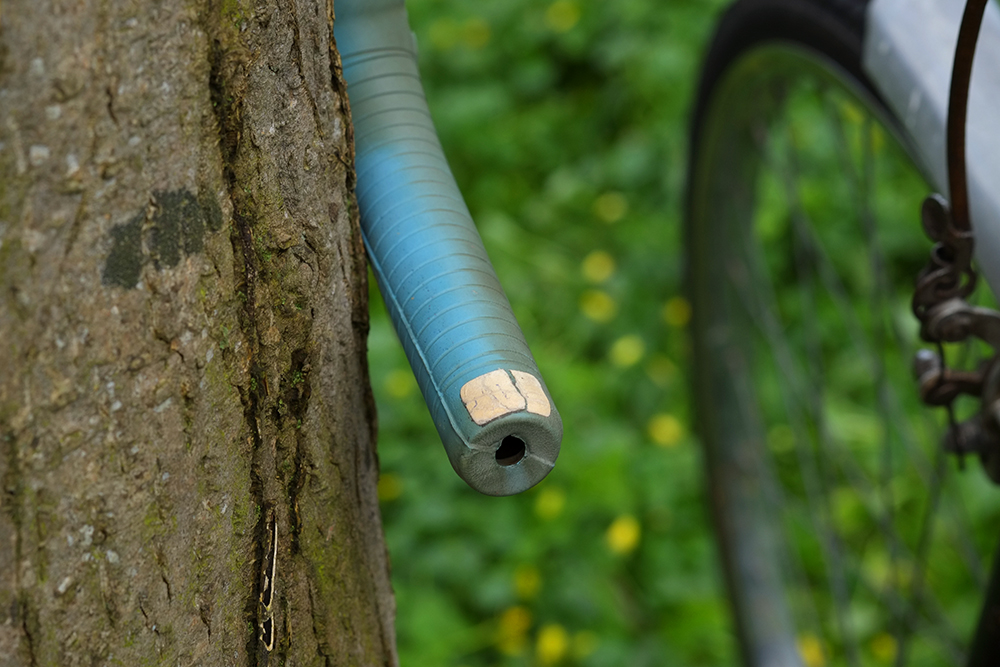
Also, the original price tag (39 cents!) is still on, and I haven't the heart to remove it.
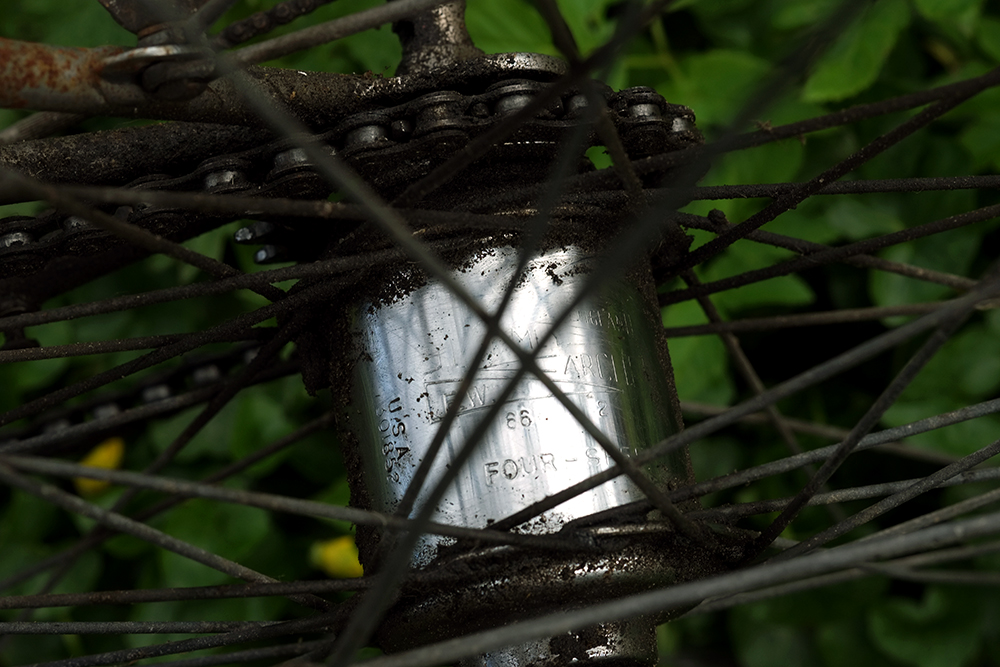
Though the bicycle was built up as a single-speed, at some point the original owner had it fitted with a Sturmey Archer 4-speed FW (wide ratio) hub - made, oddly enough, in the USA, according to the inscription. Though these hubs were produced from 1945 until 1970, they are fairly rare, so to actually have one is a real treat - even if it does not exactly "work perfectly." The hub fickleness was something Bryan warned me about when handing over the bike, though I have managed to make friends with it more or less. Basically, the gears do not always engage during shifting, and you have to sort of massage the shifter just so to get it right (though the problem is the hub, not the shifter). In the long term, I should have the hub serviced at some point. But for now I am not unwilling to deal with its quirkiness.
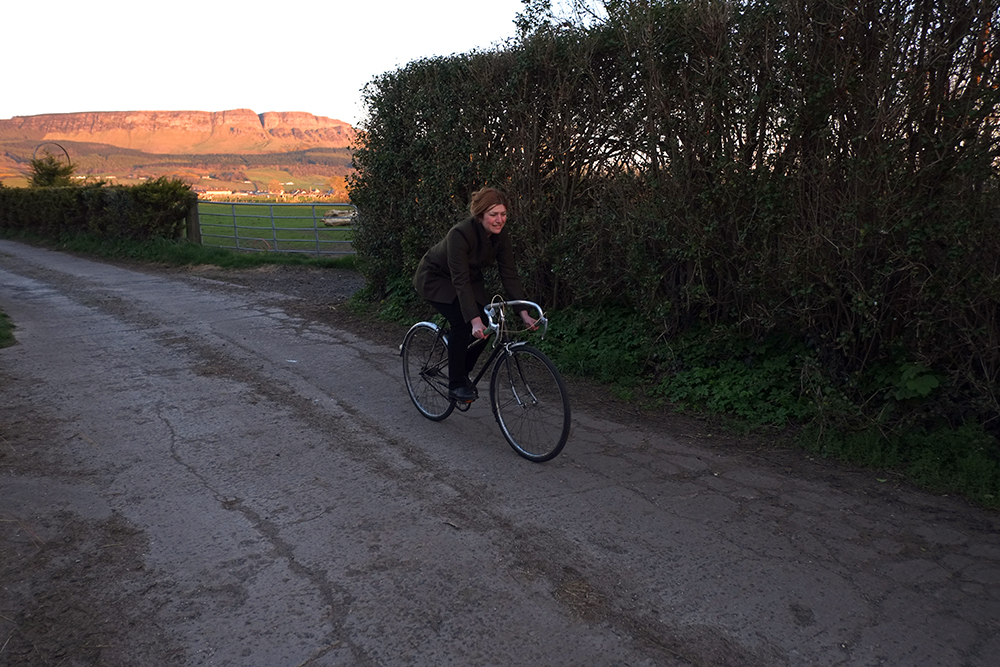
My first impression of the Claud Butler Lady Lightweight was dominated by its low drop position and its speed. The term that came to mind when riding it was "gobbling up the miles." Especially on flats, this bicycle just wanted to go all-out! It is a funny feeling to be wearing a skirt and riding a bicycle so aggressively. Fun, too!
The original plan for the Claud Butler when I first got it, was to ride it now and again for fun, take pictures. I did not really expect it to have any functional benefit. However, I soon noticed that on windy days the Claud Butler made a lot of sense as a transportation bicycle. The 7 mile trip to the nearest town is comparatively flat, but along exposed roads that can be next to impossible to tackle in a serious headwind. The compact mixte with its super-leaned over riding position is able to cut through the headwind and resists cross-winds better than my other bicycles.
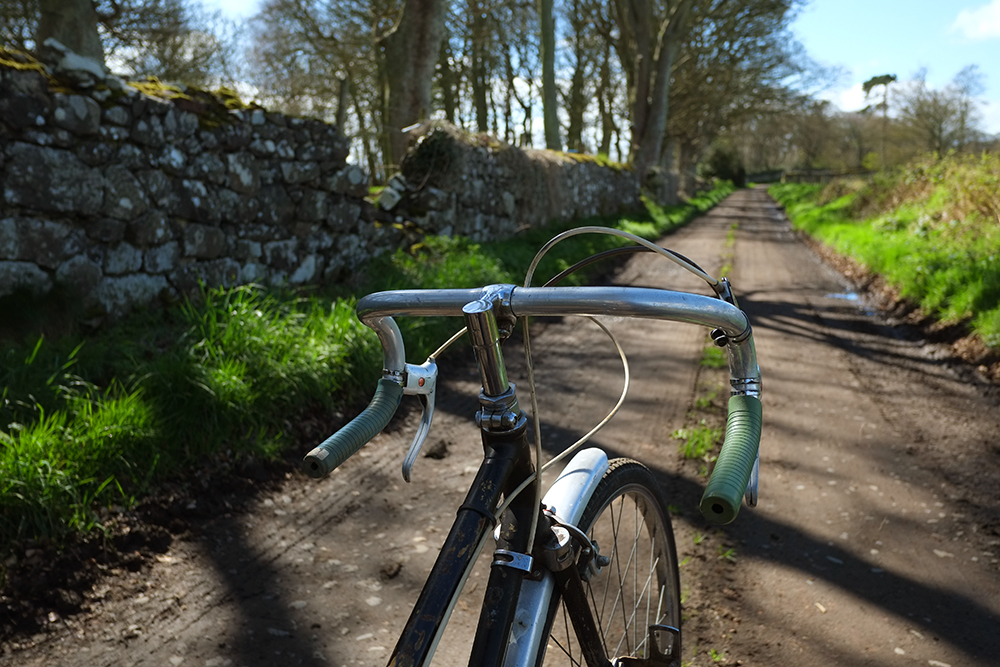
This bicycle also does very well off road - feeling extremely comfortable over rough terrain - allowing me to take all sorts of backroad shortcuts, as well as to go wandering around where I am not supposed to in pursuit of photo opportunities.
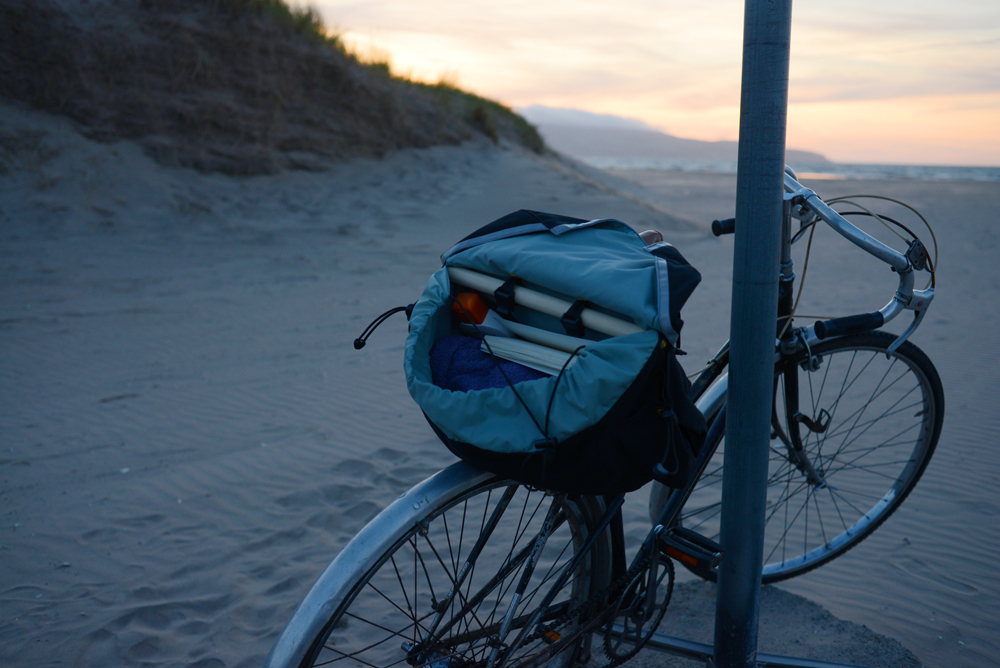
When riding for transportation, I fit the bike with an oversized Dill Pickle saddlebag, which is designed to fit a laptop and then some. I have also replaced the decrepit and much too wide pleather spring saddle the bicycle came with (not the original saddle, I feel safe in assuming), with a Brooks Cambium B17S, which I am soon due to review. It roadie profile and short nose design suits the Claud Butler very nicely.
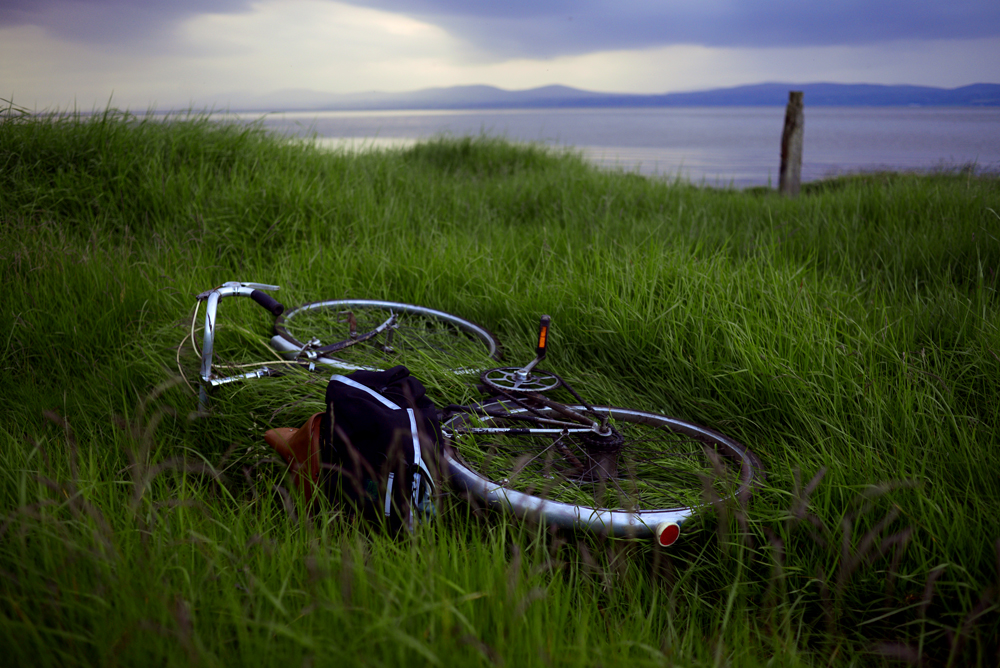
If this bicycle remains in my guardianship for the long haul, it would be nice to replace some of its worn out and aftermarkert parts with period-correct ones, as well as to give it a bit of a cosmetic polish (okay, so it needs a huge amount of cosmetic polish, I know!). But really, the important thing - to me, and to is true owner Bryan - is that the bicycle kept "alive" - through being ridden as intended. And while I don't know much about this bicycle's original owner, often I picture her riding through a similarly windswept landscape, her head bent low, fiddling with the gear shifter, the cold breeze in her face - feeling exerted but happy. This early Claud Butler mixte is a living, functional piece of history. Whether in a skirt or "rational costume," I am pleased as punch to be Claudia's current keeper!

I believe the screw is actually a grease nipple, for injecting grease to lube the headset!
ReplyDeleteDuh. Actually I knew that. (Should've known that, is what I mean!)
DeleteAllow me to offer a few clarifications.
DeleteFittings like that on hubs, head tubes and BB shells are not for injecting grease, but dripping oil. Grease formulations of that era rather quickly separated into wax and oil, and the oil would drip out the gaps in the parts, leaving the dry wax behind. Adding a few drops of oil from time to time would help freshen up the grease until it was time to overhaul the part. If you try to inject grease into it, you will fill the head tube with grease before any of it reaches the bearings.
That single top tube step-through frame design is also known as a "Sport" model.
The headset does not use not press-fit, but drop-in bearing races. They sit in the flared ends of the head tube. It is probably Chater-Lea, which also have threading of different diameter and pitch than BSC standard thread (31/32" x 30tpi vs. 1" x 24tpi). The stem is held in place by the collar on the headset top nut rather than by an internal expander.
Hey Wrench! Thanks for the info. I always thought those grease ports to be sort of a bad alternative to disassembling the BB or Headset, because like you say, it would just fill up the frame with grease before getting any where it would do any good. Now they seem like a typical pragmatic British solution to a problem that needed solving
DeleteSpindizzy
Could the "USA" stamping be referencing a US patent number below it?
ReplyDeleteYes, yes it could.
DeleteThe bike also appears to have an unusual press-fit headset.
ReplyDeletethose press-fit headsets weren't all that unusual for the time. I have a 1933 Malvern Star with a press-fit headset, and I've seen several pre-war bikes with them.
DeleteSuch a great bike. I am as unlikely to go out on a Mixte as I am to start rocking a "Murse" but the more I see of this bike and your adventures on it the more I think I'd just overlook my insecurities and go for a spin once in a while myself if it were in my basement and a bit closer to my size... So neat.
ReplyDeleteSpindizzy
Oh, BTW, the fitting on the headtube appears to be a grease fitting. Typical for best quality Brit bikes from that period I believe. That pattern of grease nipple is still used so if you root around in the barn you can probably find a pump-gun of tractor grease and give it a quick shot once in a while...
I'm sure there is a entire salutary article on "when VGAs go wrong..."
ReplyDeleteI still regret a VGA with my mid-80s Specialized Stump Jumper - it would probably now be about the same age as your Claud Butler in mountain bike years.
The details are too painful to recount even now...
Mountain bike years. I like that. Explains why all the 80s and early 90s MTBs in my pile seem like historical items from the beginning of a different civilization but my 60's and 70's roadbikes just seem like nice used bikes. Cuz' that's what they are.
DeletePeople are going to get sick of me trying to insert the term "Mountain bike years" into every conversation over the next few days...
Spindizzy
Hey Claudia! Show us your HEADBADGE! Boy oh boy, I just can't get enough headbadge...
ReplyDeleteNon of your business, that's who.
You can see full frontal headbadge in 5th picture from the top (or click here).
DeleteFunny enough I think it looks nicer with the weathered, blank surface than it did in its full former glory.
That headbadge looks like it has the Olympics logo on it. Was it some kind of commemorative bike made in that year? Or is that not the exact same badge as your bike?
DeleteClaud Butler made good bikes from the beginning, especially Track bikes so it's not impossible someone rode one onto the podium at the Olympics at some point.
DeleteThanks for the link to the headbadge (pant, pant), I've seen the stylized Olympics Rings version before and always thought it looked like it could have been from some Soviet era Russian bike. Other Claud's had a more English looking badge that was just as cool. I don't have any Butler badges in my collection but I promise not to pry yours off if I ever stumble across it locked up to a pole on a dark night...
Spindizzy
A very cool bike indeed! Can you post a profile photo of you (or someone else) riding the CB? I'd like to see what position is dictated by the "aggressive" geometry and deep drop bar. I notice too that the bar seems to be set up for riding only in the hooks -- very low "hoods", unwrapped top, tangle of cables.
ReplyDeleteEven if the top was wrapped and uncluttered, the curvature of these bars makes it very awkward to keep your hands there, so it is definitely a hook/drop only bar.
DeleteWill get a photo of me riding the bike.
Oh wait, I've got this shot. But that was shortly after I got the bike and the stem was pulled out all the way. I couldn't get it down any lower and assumed it was already touching the bottom of the headtube. However later my beloved gave it a go and turned out it was just stuck. Anyway, so the bars are much lower now and my position is different. I'll post an updated photo.
DeleteOkay, here you go. And here.
DeleteThanks. That is a rather aggressive position (at least by the standards of my aging neck) if it is the bar's default position. How many minutes can your ride like that without discomfort?
DeleteAs I've aged, I've raised my bar to within about 1" of saddle, and use long ramp, shallow drop bars (Compass Maes Parallels -- wonderful! -- if set up with ends of hooks parallel to Earth as God intended). I can ride up to about 20 minutes in the hooks, which put me in a position only a bit lower than yours in the latest photos, but I'd hate to have only that position available to me!
And to think 20+ years ago my bar was fully 6" below the saddle!
I've ridden like this for up to an hour. The position itself is fine, but it's not ideal for riding in street clothes. I may raise the bars a bit from where they currently are, so as to not stress my tops and jackets at the seams.
DeleteIt's an ordinary postwar bend, approximately a Maes bend. Look at that long straight section at the top. Not all that deep either. If the levers were given hoods and mounted at the normal position, if the bars were taped, no one would give it a second look. The 'impossibility' of the bars is entirely particular to one user.
DeleteWell, as I wrote in the post - the handlebars are Stratalite Tour de France bars, most likely from the 1950s. They are not, however, even remotely a Maes bend. The photos' suggestion of a straight section at the top is misleading; there is practically no straight section there. To hold my hands at the top, I have to hold them either right next to the stem, or with my wrists flared out at an awkward angle, as the slope begins right away. I will try to take some shots illustrating this more accurately.
DeleteThat's not straight? Ummm, OK.
DeleteOne thing to be aware of on handlebars that old- they were made from really soft alloys. If a bar has sag or droop as it exits the stem clamp it's been used and may be used up. We used to all ride them until the droop was really bad but it's hardly anything I could recommend.
Maes bend does not mean identical to a Phillipe Pro as made before lunch February 29, 1952. The "classic AVA" Maes bend now being recreated is identical to OEM on my '65 Schwinn Continental. I been looking at Maes a long time.
The little "screws" on the head tube appear to be a grease-fitting of some sort. If they are, that's a good idea, though less than glamorous looking.
ReplyDeleteLike the bike!
Wolf.
Nice bike and nice post! It's a little hard to tell from the pics, but the screw on the head tube looks like maybe a zerk fitting (grease) to me?
ReplyDeleteA very appealing graceful yet athletic form to this bike. Really exhibits mystery and charm. She pulls her own weight I daresay and you are more her copilot as you fly along than "keeper" or guardian. Thanks! Jim Duncan
ReplyDeleteI love that kind of bike... very nice...
ReplyDeleteThat is some serious Patina but well deserved after being around for 80 years. I doubt Mr. Butler was thinking about whether any of his creations would still be tooling around in 2015, he was probably worrying about making payroll, but I bet it would make him smile to know Claudia is roaming Irish roads today.
ReplyDeleteThat bike is such a treasure. The fact that it came your way is a testament to your impeccable bike karma. I would be deathly afraid of doing serious damage to spokes and rims by riding it. I trust that the bearings were properly serviced before your VGA. I have been rebuilding a '76 Schwinn Super le Tour -- a $35 Craigslist treasure. The grease in the hubs, headset, pedals and bottom bracket had the consistency of wet sawdust. The front wheel barely spun. Fortunately all bearing races were in good shape, no pitting. After cleaning and regreasing, everything is spinning good as new. It's fun getting old bikes back on the road where the belong.
ReplyDeleteForgot to mention: Loved the period correct zip ties on Claudia's top tube. Well played.
DeleteIf patina adds anything, then zip ties do, too. It's all about balance.
DeleteAlas I cannot take credit for those gorgeous zip-ties.
DeleteFor years I kept the corpse an early 60's entry level Bianchi that had been creamed by a car because some of the details were really special, probably my favorite little thing about that relic was how someone kept the cables from flapping around by binding them to the frame with thin brass wire with the ends tucked artfully under the. Just a narrow 1/2" band an inch or so away from the cable stop on the frame so you could see a bit of housing between the wire and the stop. Over the years the brass had aged to a mottled bronze. That and the dull Celeste paint and rampant rust made that bent up old gas-pipe Bianchi look like some ancient weapon un-earthed from some Viking Kings forgotten hoard. Eventually I realized I was going to end up divorced and homeless if I didn't get rid of 6 tons of that sort of thing and took it to the scrappie to be turned into a new Hyundai. I did save the seatpost clamp though.
DeleteSuch a gorgeous, classic racer. An early sloping top tube hi-performance bike.
ReplyDeleteI'm just going to make a small quibble with your description of mixte stays as "parallel". They are diverging after all. But what's a better term? Laterally aligned?
Good point. Just calling them twin stays would probably be most accurate.
DeleteImagine finding the original oilskin toolpocket with original tools in it. Wet dream. And then on top of that the original "lightweight" pump. OOOmmph!
ReplyDeleteSTOP! STOP! It's not a wet dream, it's a freaking CRUSADE!
DeleteThose things MUST still be out there! If we only knew WHERE TO START SEARCHING! I HAVE to find them!!! ARGGGHHHH!!!! I would be miserable every time I happened to think about those things in the middle of a glorious ride on a beautiful spring day on that bike.
Man I HATE old bikes. They make me crazy.
Spindizzy
My thing would be more to find period-correct lighting for that sexy bracket on the fork, then fit it with modern innards. Girl also needs some lightweight plastic Bluemels, as I don't believe the mudguards currently on are correct.
DeleteThere are both 6V and 12V LED-bulbs for e10 fitting. e10 is the kind of fitting you´ll find in old headlights. That way you don´t have to rebuild your old headlight. Not as strong as a modern multibulb LED-light, but good enough.
DeleteV-
DeleteLucas King of the Road
http://www.ebay.co.uk/itm/LUCAS-KING-OF-THE-ROAD-HEADLAMP-Vintage-1956-S-NOS-/171752846453?pt=LH_DefaultDomain_3&hash=item27fd447475
The one offered in that listing is more perfect than any I've seen but gives you a good idea. Buckets of room inside to fiddle your wires and bulbs. With the huge reflector (if you get a good one) you might even be able to ride incandescent.
I don't see how you ride those slippery levers and extra deep sloping handlebars. It's a cool bike, though. Glad you have it.
ReplyDeleteThe levers are actually not slippery. But otherwise yeah, this has always been my worst nightmare setup as far as vintage handlebars. Weirdly though, it makes sense on this bicycle.
DeleteFront right brake pad is badly misaligned. The cable runs for the brakes are just atrocious. The casings appear to be kinked and are past due for replacement. Run the rear brake cable up and over and behind the handlebar, then underneath the stem extension. At the rear actuate the caliper from underneath rather obliging the cable to turn 180 degrees. Those are just 60s Weinmann sidepulls. Many ladies Schwinns (with the identical brake) came direct from the factory with actuation from below and any dealer who knew his job set the rear brake up that way. The cables would probably benefit from being braced/wired to each other.
ReplyDeleteMy experience with the FW hub is limited to 600 examples. Two shipping containers of Raleigh Sports special ordered with that hub. Both owners and mechanics had far fewer problems with the FW than with AWs. You are probably safe but the sooner the hub is serviced the better.
It's a headclip headset. The pinch bolt secures head bearing adjustment and clamps the stem. With those big belled headlugs there might be a small pressed bearing race or a bearing race could be lapped directly into the metal of the lug.
What's being called a pleather saddle was a mattress saddle. All the English saddlers made them. Quite appropriate for this cycle. Widely used by sporting riders.
The late Oscar Wastyn called this frame style a ladyback. Said he'd acquired the term from English builders. In French it would be called a sport. Usage on such a point is going to vary but this is not a mixte.
Indeed many parts need servicing or replacement; this post was already so long I did not go into that in detail. To clarify, I did not plan to ride this bicycle beyond parade-mode when it first came to me. But since it clearly has become a transportation machine, now that it's springtime I am starting to make updates. The cables and brake pads are being replaced next. Then I'd love to find someone qualified to service that hub, which won't be easy here.
DeleteI am aware of early mattress saddles, and, according to the catalogue, it is possible this bicycle originally came with a Terry. However, the mattress saddle that was on the bike when I got it was not original, but maybe a '60s-70s replacement.
I thought a layback frame referred to the style seen on page 7 of this catalogue. Similar construction to this CB, but without the rear stays.
A ladyback is also, I think without much dispute, a tandem with an open rear frame. I would've called the page 7 frame a 'ladies' with no further qualification. The frame style you have needs a name. Oscar's call is good by me but if you never knew Oscar.... There really aren't that many frames like this. There were a couple production batches of Schwinn/Panasonics to the pattern. There are Schwinn Worlds and Superiors and Paramounts but they may all be one-offs or Wastyns. Herse and Singer and other constructeurs made a few. Jack Taylor made a slight variant. Your Claud. Regardless of how small the numbers it is very distinctive and the best mechanical solution.
DeleteWorking on Sturmeys is mostly getting over the fear of opening the can. After that it is pretty straightforward except for finding parts. You can always send it to Phoenix Hub Gear or your pal Nick. Appeals for help finding parts on something like that are normally answered with enthusiasm.
Once you get the brakes cabled you will like how positive and powerful the brakes are. Weinmanns have no cachet at all because they were produced by the million. More 'correct' brakes could be had but in most all cases there would be a big question mark how safe they were. I have never seen or even heard of a defective Weinmann brake part. Never seen an imprecise part. Any failure I've ever been aware of involved large human error. Every detail is overbuilt, over-engineered, understressed, and proven. And they remain reliable into old age. Remember these same brakes were raced, taken down gravelled mountain roads, beat up my ten million children, and they still work. If anyone thinks the levers are slippery new production rubber hoods are still made by Cane Creek and it's simple to locate a wide range of vintage hoods.
I've torn down a bunch of Sturmey hubs now and have come to the conclusion that any hub that doesn't make crazy noises or fight back when you try to shift, likely doesn't need to be opened up beyond servicing the cones and bearings. If it slips, hesitates to settle into gear or simply makes whirrings and purrings that it shouldn't make I now try light oil in big doses via the oiling port on the hub and letting it sit idle for a day or so, then doing it again and again till the oil runs out clean. Maybe laying it on one side for a day then flipping it onto the other for a day. Most issues on mine seem to be from dried up lube and dirt. If you soak and flush as much out as you can they sometimes wake up and work amazingly. It's also amazing how much corruption runs out of them during the process. I swear I've seen ant cadavers come out. ANTS!
DeleteI also think Weinmann brakes are under-rated gems. If they had only made a thousand sets a year for 5 years in the 50s people would fall all over themselves to get their hands on them. The fact that they were ubiquitous gives them the odor of the lowest common denominator which is a sign of the SORRY state of things these days. I put a well massaged set of Weinmann center-pulls on my Mercian and all my friends think it's because I'm cheap(which I am) but they never seem to notice how freaking well that bike stops. It's also quieter than just about any other bike my friends ride. When polished a bit and set-up carefully with Kool-Stop pads I believe they are functionally the equal of Mafacs if not quite so pretty. If you do it right they stop as well as ANY bolt on rim brake I've tried and if you don't have braze-ons they are easier to keep from squealing than Mafacs (which I also really like and use). The sidepulls are as good as just about any of their type as well but again, suffer from having been common as dirt.
I can never bring myself to throw good Weinmanns away and even the horrible ones get stripped of the hardware before getting thrown into the fiery furnace.
Spindizzy
Never cared much for the levers though. But lighter than most anything but the crappiest plastic ones...
DeleteSpindizzy
Hi Spin
DeleteBut it's so fun at least the first twenty times you open the can.
My sweetie was on Campagnolo and exclusively Campagnolo 1968-2013. For Christmas 2013 she got a 1967 Falcon (still a total handbuild then) with Weinmanns. No dropbolt was getting the pad to the rim. She liked the bike a lot. She did revert to Campy levers and I did get her Koolstops. She still has the Campys on the other bike but prefers the Weinmann.
I left a note for you on the previous thread. Look.
Thanks Anon... that was a better explanation than I was giving my "Lovely Wifecycle", I suspect she might even be into taking a ride soon just to try some of this out. I'll have to lure her into trying the "Ladies" DL1 I use for a rack building "Mule" and hope she let's me have it back when she's done...
DeleteSpindizzy
Nice bike and nice to see the all the green coming out! It could be fun to copy the geometry and make modern day version of this fast go, everywhere bike with Alfine 8 (or 1x9 with brifters), reynolds frame, wide tires etc.
ReplyDeleteBluemels Airweights alloys or the black plastic All Rounder.
ReplyDeleteA link on Classic Rendezvous brought me here today!
vsk
I'm no Sheldon Brown, but after perusing these lovely photos, I started to wonder whether Claudia's brake calipers could be from a later era. On the other hand, maybe quick-release mechanisms were available during the 30s. Does anybody know?
ReplyDeleteYup, the brake levers and calipers are replacement Weinmanns. The original brakes are described in the catalogue only as "front and rear lightweight calipers (2 brakes), or to order" so not sure what they were.
DeleteHow old are the chain and cog?
ReplyDeleteThe review the CB mixte is intriguing, as expected. The VGA concept is one I'll have to remember.
ReplyDeleteMy reason to post is say how much I enjoyed the photos, especially the last. Not sure how to describe the qualities that I find so compelling... the deep colors, the semi-abstract nature of it,...? I just know that I find it compelling. Thanks for the fine blog and photos!
Am I the only one who got the title?
ReplyDeleteIt makes me grin every time I see it, and say "Cwawdia" to myself.
That bike is cooler than the cool side of the pillow. Are those EA 3 or EA 1 rims?
You might be the only one, Corey - I don't have a scooby. :) Care to enlighten us?
DeleteNot to put words in Corey's mouth, but this is what I "get" from the title:
Deletehttp://en.wikipedia.org/wiki/I,_Claudius
... published in 1934, so quite appropriate!
Charlie
Ding! Ding! Ding!
DeleteWait, are you really the only ones that got this?? And I thought I was being rather heavy handed with that title...
DeleteIf I was ever to restore a vintage bicycle, I’d want to take it right back to the way it was when it left the factory, or even better, finish-wise – like Donald Shimoda’s Travel Air 4000 in ‘Illusions...’ I expect most vintage bike owners/enthusiasts would make the sign of the cross if you suggested that, but it’s what I’d want to do with Dora, your Triumph. But, notwithstanding any maintenance or mechanical issues you need to sort, I’d want to throttle anyone who tried to do that to Claudia – she’s just perfect the way she is – even the grease and the dirt look sacrosanct. And even though the handgrips are ‘period correct’, they’ll never catch up with the rest of the bicycle unless you age them somehow – even the purple bar tape on your Seven has a lovely patina now. You could try painting the grips with natural yoghurt and leaving them out in the sun for a few days – that’s how antique dealers put 100 years on a terracotta pot they bought last week out of Aldi (you have to hope your friend Nick doesn’t read this or he’ll be getting ideas – Spindizzy’s already off to the shops for the yoghurt!), but I don’t suppose that would be very hygienic. Maybe next time (or the next few times) you’ve been working in the garden/allotment just don’t wear gloves and don’t wash your hands before you go for a ride. You could even let that wee shite of a Shetland pony have a nibble at them, but I guess that would be a step too far. :)
ReplyDeleteMy first thought was to follow Livia's advice: Don't eat the figs!
ReplyDeleteNice bike!
ReplyDeleteIndeed the mixte frame with two lateral tubes was designed in France, by Albert Six in the first half of the 1930s.
I'm not sure when André Reiss of Cycles Reyhand in Lyon slightly improved on the design, but it must have been before your Butler was built, as he was credited with the design of the mixte frame with a single "top tube".
This bike looks quite sweet - in need of a little tidy up (those cables) - but nice to see it is still in use.
ReplyDeleteGorgeous bike and detective work, V! Thank you for sharing with me. The mixte you sold me is going strong and I have drops on it and am using it for light touring! -- Pam
ReplyDeletehttp://sheldonbrown.com/sturmey-archer/service.html suggest service of hub sooner rather than later. I've been enjoying the comfort of a Brooks Cambium for a year, very good, and so good looking that I worry for it's safety.
ReplyDeleteHello
ReplyDeleteWas looking long time to try to identify the model of a vintage Claud Butler ive got and i manage to find is a Ladies Lightweight
but i cant find which year . The frame its lugless.
Thank you Veluria .Reading this article i decided to finally restore this bike